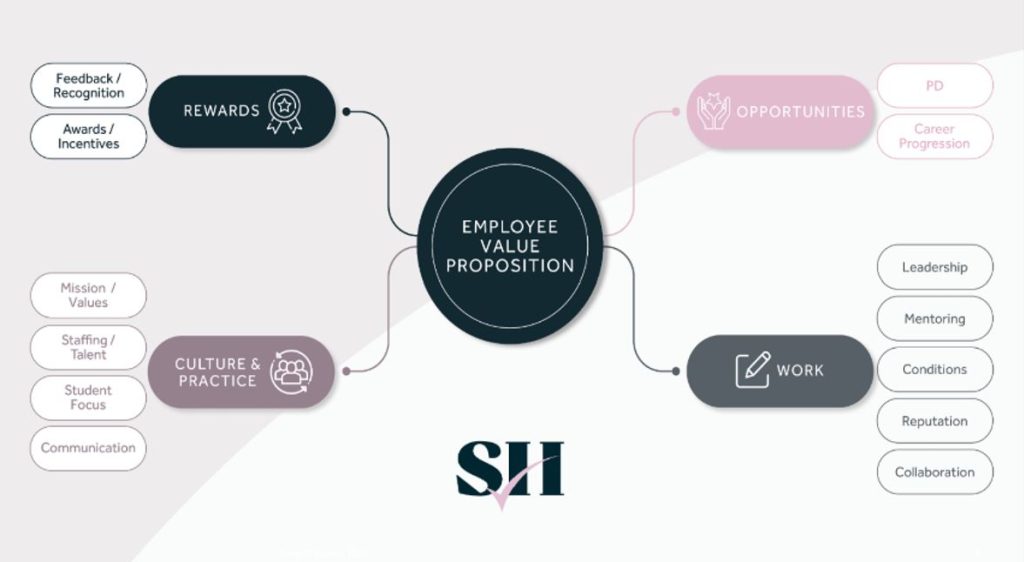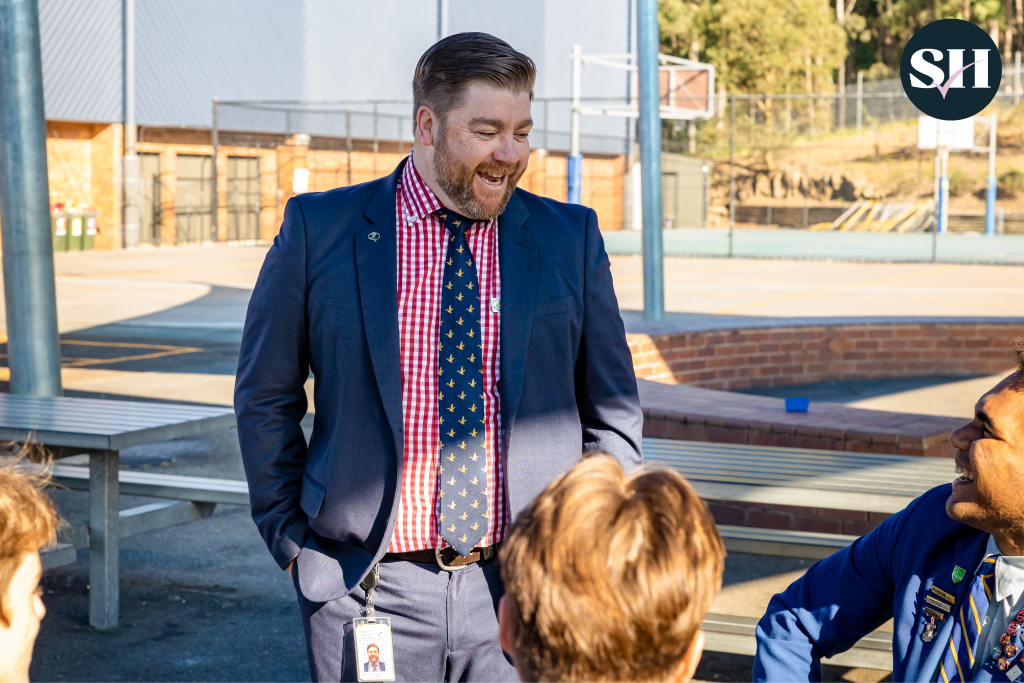In our last article we examined the planning stage of the recruitment cycle. Today we move to the resourcing stage of the recruitment cycle.
Planning > Resourcing > Attraction > Selection > Evaluation > Induction
With the help of recruitment, marketing, and education experts, we will try to answer the question:
What resources help schools to better attract and select candidates during the critical labour shortage?
Employer Branding Power
We surveyed our database of active job seekers in Term 2 to gain insights into why candidates accept one job over another. 26% of respondents selected culture (team spirit, values and support) as their number one reason. This was followed by compensation (salary, promotion opportunities) at 21%, work environment (challenges, autonomy, recognition) at 20%, benefits (holidays, flexibility and time off) at 18% and career (development, training, consultation) at 16%.
Scan job advertisements or school websites and you will be hard pressed to find information related to the categories above. Advertisements focus on the technical requirements of the job and school branding does not carry the same weight from an employment perspective as it does for learning and education.
Is there a recruitment solution to be found here?
According to experienced education and medical recruiter Ryan McKenzie, “a big reason why hired candidates last in a job is because they fit the work environment and culture. Yet a candidate’s ability to access this information comes at the interview stage or for many not until after they commence. A lot of teachers register with our recruiters for the first time after they have started a new position. They say the job was a match, but not the school and hope we can help them find something new.”
A recruiter’s knowledge of a school is shared with equal emphasis on job specifications at the time a job opportunity is introduced. So, why can’t a school do the same? The employee value proposition is one resource that can bring a school’s employer branding to the forefront.

According to Ryan, the employee value proposition (EVP) contains information that when shared with candidates promotes your school as a place of employment. Just as you try to give prospective students and parents an understanding of what the learning culture, environment and community is all about, a well thought EVP can do the same for prospective employees.
Our SchoolHouse recruiters use the following framework when building an EVP for our customers and soon our website will help schools self-manage this process. There is a lot more you could also focus on or prioritise, notably in the opportunities, culture and practice and work categories. The idea is to make the document yours – shine a light on what makes YOUR school a great place of work.
A successful EVP will bring to life what working at your school is all about. It needs to be a document that a school leadership team – notably those managing the recruitment process – should be able to communicate. Prioritise what is truly unique and don’t shy away from presenting the challenges of working at your school. When asked what was missing before accepting their last job, 43% of survey respondents chose any information that showed what was challenging about working at the school.
“a big reason why hired candidates last in a job is because they fit the work environment and culture.”
Reinforce your EVP with input from your staff. 31% of survey respondents felt testimonials or feedback from existing staff would have been most helpful before accepting their last job. Whatever you choose to focus on, be authentic and bring it to life by making sure it is easily accessible to prospective candidates.
SchoolHouse staff have already started to help schools build their EVP and will soon offer you a platform to make these public to our community of teachers, support staff and school leaders. If you are interested in this solution, please get in touch with the SchoolHouse team.
The Position Description – a link between recruitment and retention
A quality position description links recruitment and retention. Build your PD with a clear purpose and desired result. Ensure these align with your school strategy and broader goals, and not just the technical requirements.
- Create a list of the key technical responsibilities of the role; that is, the inputs required to deliver quality operations. For teaching, the Australian standards can be used to great effect. Don’t be led by a number – if the role requires a longer list of technical responsibilities so be it – and avoid “and any other responsibilities required”.
- For each responsibility, list the core capabilities required to perform the responsibility to great effect. This takes time but once completed can be easily mapped into an appraisal form to be used post hiring.
- Now move onto the organisational/cultural responsibilities. These will be broader and apply to all roles within the school with variances dependent on where the role sits. For example, all teachers can have the same organisational responsibilities and capabilities, while middle managers and senior leaders would have additional responsibilities. Making the different organisational/cultural responsibilities transparent in every PD is a great way to connect each role to the greater purpose and workforce of the school. It also helps in areas of progression.
According to experienced school leader Glenis Gumley, “The role description should be compiled by the appropriate executive member(s), but it also needs feedback from the person who will be leading the team to ensure that it is accurate and covers all of the responsibilities.”
SchoolHouse staff are experienced in the development of position descriptions for all roles within a school, notably senior or executive level roles. If you are interested in any assistance, don’t hesitate to let us know.
Safeguarding
Spending time at the start of the process on developing application forms, interview questions and other activities that help you deep dive into a candidate’s performance and conduct will help safeguard your school. This is important once we reach the next stages of selection & appointment.
Where the registration authorities offer education qualification verifications and police clearances, application forms can help schools probe reportable conduct by seeking information related to the suspension of registration and disciplinary proceedings. Interview questions need to be widened to cover a candidate’s conduct so that panels can measure their maturity, boundaries, emotional intelligence, and child protection training history.
Conclusion
The current education labour market is such that schools need to be better prepared to compete for quality applicants. Recruitment campaigns must shine brighter by sharing the information that is more meaningful to candidates. Schools need to build their employer branding, which in time will help attract more suitable candidates.
As many Principals say, the problem today is not just recruitment, but the retention of quality candidates.
Resources such as the PD can not only enhance strategic hiring but can be easily adapted to retention documents such as appraisals and progression plans, creating a thru-line from recruitment to retention.

SchoolHouse is comprised of staff with extensive education recruitment, teaching, and school marketing experience. We offer flexible services that help schools recruit and retain quality staff. Currently we are seeking customers interested in trialling a new product that allows schools to quickly create resources, simplify their advertising and promote themselves as an employer of choice for support staff, teachers and school leaders seeking employment in schools.
For more information contact our team by emailing recruitment@the-schoolhouse.com.au
Additional Articles
Best Practice – Recruitment Planning
Best Practice – Advertising and Attraction
Best Practice – Selection and Appointment
Best Practice – Induction and Evaluation
Biographies
Glenis Gumley
Glenis is an experienced school leader whose career has included the key roles of Head of Houses, Head of Senior School and Deputy Principal across several leading independent schools in Melbourne. She has also worked in the tertiary sector and is currently employed at Melbourne University in the Graduate School of Education.
Ryan McKenzie
Ryan is an experienced recruiter who has provided recruitment support to Government, Catholic and independent schools. Ryan is joined at SchoolHouse by several highly experienced education recruiters who do all that was shared in this article and more to support schools.
